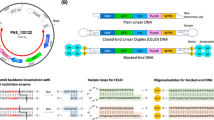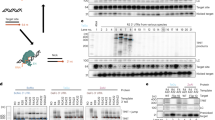Abstract
The nuclear envelope represents a key barrier to successful nonviral transfection and gene therapy both in vitro and in vivo. Although the main purpose of the nuclear envelope is to partition the cell to maintain cytoplasmic components in the cytoplasm and nuclear components, most notably genomic DNA, in the nucleus, this function poses a problem for transfections in which exogenous DNA is delivered into the cytoplasm. After delivery to the cytoplasm, nucleic acids rapidly become complexed with cellular proteins that mediate interactions with the cellular machinery for trafficking. Thus, it is these proteins that, in essence, control the nuclear import of DNA, and we must also understand their activities in cells. In this review, we will discuss the principles of nuclear import of proteins and DNA–protein complexes, as well as the various approaches that investigators have used to improve nuclear targeting of plasmids. These approaches include complexation of plasmids with peptides, native and engineered proteins, ligands and polymers, as well as the inclusion of transcription factor-binding sites for general and cell-specific delivery. Keywords:nonviral gene transfer∣plasmid∣nuclear pore complex∣importin∣nuclear localization signal∣karyopherin.
This is a preview of subscription content, access via your institution
Access options
Subscribe to this journal
Receive 12 print issues and online access
$259.00 per year
only $21.58 per issue
Buy this article
- Purchase on Springer Link
- Instant access to full article PDF
Prices may be subject to local taxes which are calculated during checkout




Similar content being viewed by others
References
Miller AM, Dean DA . Tissue-specific and transcription factor-mediated nuclear entry of DNA. Adv Drug Deliv Rev 2009; 61: 603–613.
Cohen RN, van der Aa MA, Macaraeg N, Lee AP, Szoka Jr FC . Quantification of plasmid DNA copies in the nucleus after lipoplex and polyplex transfection. J Control Release 2009; 135: 166–174.
Glover DJ, Leyton DL, Moseley GW, Jans DA . The efficiency of nuclear plasmid DNA delivery is a critical determinant of transgene expression at the single cell level. J Gene Med 2010; 12: 77–85.
McLane LM, Corbett AH . Nuclear localization signals and human disease. IUBMB Life 2009; 61: 697–706.
Brohawn SG, Partridge JR, Whittle JR, Schwartz TU . The nuclear pore complex has entered the atomic age. Structure 2009; 17: 1156–1168.
Young JL, Zimmer WE, Dean DA . Smooth muscle-specific gene delivery in the vasculature based on restriction of DNA nuclear import. Exp Biol Med 2008; 233: 840–848.
Degiulio JV, Kaufman CD, Dean DA . The SP-C promoter facilitates alveolar type II epithelial cell-specific plasmid nuclear import and gene expression. Gene Therapy 2010, (e-pub ahead of print).
Miller AM, Dean DA . Cell-specific nuclear import of plasmid DNA in smooth muscle requires tissue-specific transcription factors and DNA sequences. Gene Therapy 2008; 15: 1107–1115.
Miller AM, Munkonge FM, Alton EW, Dean DA . Identification of protein cofactors necessary for sequence-specific plasmid DNA nuclear import. Mol Ther 2009; 17: 1897–1903.
Munkonge FM, Amin V, Hyde SC, Green AM, Pringle IA, Gill DR et al. Identification and functional characterisation of cytoplasmic determinants of plasmid DNA nuclear import. J Biol Chem 2009; 284: 26978–26987.
Lachish-Zalait A, Lau CK, Fichtman B, Zimmerman E, Harel A, Gaylord MR et al. Transportin mediates nuclear entry of DNA in vertebrate systems. Traffic 2009; 10: 1414–1428.
Yang Z, Sahay G, Sriadibhatla S, Kabanov AV . Amphiphilic block copolymers enhance cellular uptake and nuclear entry of polyplex-delivered DNA. Bioconjug Chem 2008; 19: 1987–1994.
Breuzard G, Tertil M, Goncalves C, Cheradame H, Geguan P, Pichon C et al. Nuclear delivery of NFiB-assisted DNA/polymer complexes: plasmid DNA quantitation by confocal laser scanning microscopy and evidence of nuclear polyplexes by FRET imaging. Nucleic Acids Res 2008; 36: e71.
Choi Y, Jeon YH, Kang JH, Chung JK, Schmidt M, Kim AC . MIDGE/hNIS vaccination generates antigen-associated CD8+IFN-gamma+ T cells and enhances protective antitumor immunity. Int J Cancer 2007; 120: 1942–1950.
Xavier J, Singh S, Dean DA, Rao NM, Gopal V . Designed multi-domain protein as a carrier of nucleic acids into cells. J Control Release 2009; 133: 154–160.
Duvshani-Eshet M, Keren H, Oz S, Radzishevsky IS, Mor A, Machluf M . Effect of peptides bearing nuclear localization signals on therapeutic ultrasound mediated gene delivery. J Gene Med 2008; 10: 1150–1159.
Kim H, Kim HA, Bae YM, Choi JS, Lee M . Dexamethasone-conjugated polyethylenimine as an efficient gene carrier with an anti-apoptotic effect to cardiomyocytes. J Gene Med 2009; 11: 515–522.
Chen X, Kube DM, Cooper MJ, Davis PB . Cell surface nucleolin serves as receptor for DNA nanoparticles composed of pegylated polylysine and DNA. Mol Ther 2008; 16: 333–342.
Vandenbroucke RE, Lucas B, Demeester J, De Smedt SC, Sanders NN . Nuclear accumulation of plasmid DNA can be enhanced by non-selective gating of the nuclear pore. Nucleic Acids Res 2007; 35: e86.
Author information
Authors and Affiliations
Corresponding author
Ethics declarations
Competing interests
The authors declare no conflict of interest.
Rights and permissions
About this article
Cite this article
Lam, A., Dean, D. Progress and prospects: nuclear import of nonviral vectors. Gene Ther 17, 439–447 (2010). https://doi.org/10.1038/gt.2010.31
Received:
Revised:
Accepted:
Published:
Issue Date:
DOI: https://doi.org/10.1038/gt.2010.31
Keywords
This article is cited by
-
Limitations of the Plasmid-Based Cas9-Zinc Finger Fusion System for Homology-Directed Knock-In in Chinese Hamster Ovary Cells
Biotechnology and Bioprocess Engineering (2023)
-
Targeting the Inside of Cells with Biologicals: Chemicals as a Delivery Strategy
BioDrugs (2021)
-
Biomaterial-guided delivery of gene vectors for targeted articular cartilage repair
Nature Reviews Rheumatology (2019)
-
Non-viral gene delivery systems for tissue repair and regeneration
Journal of Translational Medicine (2018)
-
Generation of gene-edited rats by delivery of CRISPR/Cas9 protein and donor DNA into intact zygotes using electroporation
Scientific Reports (2017)



